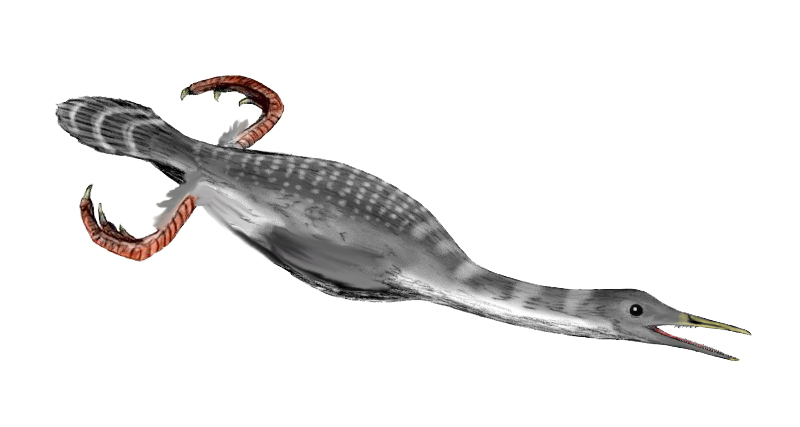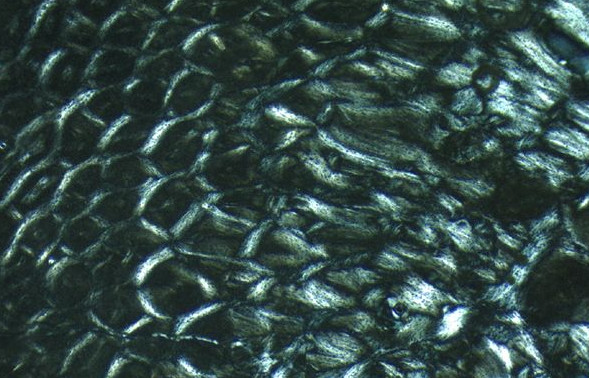Can penguins tell us how far the Cretaceous diving bird Hesperornis wandered?
Don’t mess with Hesperornis. It was a flightless, aquatic Cretaceous bird that measured up to six feet long, had a beak lined with sharp teeth, and was partially responsible for the downfall of at least one scientific career*. It superficially resembled a loon or a penguin–unlike penguins, though, Hesperornis probably propelled itself using its feet rather than its stumpy wings. Hesperornis also had a wide range–fossils within North America are known from Arkansas up to the Arctic Circle. Even during the comparatively balmy Mesozoic, winters would have been cold in the far north. Today’s birds (including many penguins) with this kind of geographic range are often migratory–so was Hesperornis migratory with the changing of the seasons, or did it stay put year-round?

For living species, you can track migration with banding or radio tracking devices. There’s no such luxury for fossil birds, which are sort of…stationary. Bones are all we have. Two major possibilities exist to parse out possible migration patterns: isotopic analysis (looking at the chemical makeup of the bones, which can be affected by where an animal gets its food and water) and bone histology (microanatomy).

Paleontologists Laura Wilson and Karen Chin set out to determine if bone histology might hold a record of ancient migrations by Hesperornis and its closest relatives. Bone tissue is affected by the way an animal grows–if an animal grows quickly and without pause, the bone shows one pattern, and if an animal grows quickly but experiences pauses in growth (or if it grows slowly), another pattern of bone shows up. Studies in non-avian dinosaurs have reached varying conclusions about what bone anatomy says regarding potential migrations, although an overall opinion seems to be that dinosaurs at high (Arctic) latitudes might show more prominent growth marks than their more southerly relatives, due to sharply distinguished seasons. If an animal stayed put for the winter, the cold temperatures (and associated decrease in food availability) would have slowed down its growth. An alternative viewpoint suggests that sharp growth marks resulted from the stress of migration, and still another viewpoint posits that you can’t really tell much of anything about migration from bone microanatomy. At least part of the conflicting story resulted from a dearth of studies on modern migratory and non-migratory animals that were good analogues for Mesozoic animals.
Penguins to the rescue! Conveniently, today’s penguins are rather aquatic animals (similar in this respect to Hesperornis), some of which are quite migratory during their lifetimes and others of which stay fairly close to home. Some species grow fairly quickly, and others grow slowly by comparison. Because we can understand the generalities (and many specifics) of modern penguin behavior, they make good lenses through which to interpret the past.

Wilson and Chin sampled four specimens of Hesperornis (three from Kansas in what is now the Midwestern United States, one from Nunavut in the Canadian Arctic) as well as a spectrum of individuals from three different penguin species with a variety of migratory behaviors (Adélie, gentoo, and chinstrap penguins–all members of the genus Pygoscelis). Hind leg bones were cut up, glued to a microscope slide, polished, and examined under high magnification.

None of the penguin bones–for migratory or non-migratory species–showed evidence of growth marks; thus, this feature isn’t reliable for inferring migration patterns. Interestingly, the non-migratory gentoo penguin showed some differences in the basic fabric of the bone from its migratory kin. These features included more radial bone and higher vascular canal densities (related to the number of blood vessels permeating the bone). Wilson and Chin suggest, based on comparisons with other animals as well as growth rate data for penguins, that these features are related to a very rapid growth rate in gentoo penguins. This may be related, in part, to the need for the penguins to reach full size prior to the start of the harsh Antarctic winters. More study is needed, they note, particularly to see if these patterns hold throughout the rather larger range of gentoo penguins (the sample used here was from the southerly limits).
Overall, the Hesperornis from north and south didn’t differ in any substantive way that couldn’t be attributed to differences in the age of the animals at death. Importantly, it looks like the animals reached skeletal maturity (adult size and a cessation of major changes in the skeleton) within a year of hatching. Thus, even if migration patterns caused stresses to the body that could show up in the skeleton, they probably wouldn’t be visible in Hesperornis. They just didn’t grow enough after the first year to show this kind of seasonal skeletal marking, similar to penguins today. This could be interpreted two ways: 1) the animals got big enough, quickly enough, to be able to migrate long distances soon after hatching; or 2) the animals got big enough, quickly enough, to be able to tolerate long, cold winters. Unfortunately, we can’t tell from the evidence at hand.
This uncertainty might be frustrating to some (did Hesperornis migrate, or not?!), but that shouldn’t overshadow the major accomplishments of this study. First, there is now a lot more information about how one ancient bird grew–the study by Wilson and Chin greatly expands the previously published sample for Hesperornis, particularly in terms of geographic representation. Secondly, the study provides a major new dataset on the bone of extant penguins, which helps interpret both life in the past and life in the present. Bone histology may not hold the keys to tracking ancient migrations after all.
The research was published in a new open access journal, Royal Society Open Science. It’s excellent to see an expanding number of open access venues, and equally excellent to see scientists using these venues!

*When O.C. Marsh published his United States Geological Survey monograph on toothed birds (including Hesperornis), it was decried by some in the Washington establishment as evidence on the boondoggle of federally funded science (among other things–the full situation was quite complex and ugly). That controversy led, in part, to funding cuts for the USGS, including the loss of Marsh’s position with the survey. The more things change, the more they stay the same.
Citation
Wilson, L. E., and K. Chin. 2014. Comparative osteohistology of Hesperornis with reference to pygoscelid penguins: the effects of climate and behaviour on avian bone microstructure. Royal Society Open Science 1:140245. http://dx.doi.org/10.1098/rsos.140245
